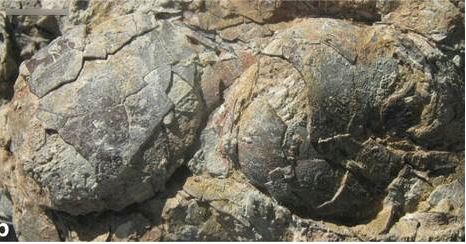Now in the collections of the Transylvanian Museum Society in Cluj Napoca, Romania, the samples date from the late-Cretaceous period (approx. 70 million years ago) and were discovered near the city of Sebeş in Transylvania by local palaeontologist Mátyás Vremir about nine years ago.
Led by Centro Regional Universitario Bariloche in Argentina, the scientists examined sophisticated electron microscope images of the unique, fossilized material from the site. They established it contains four different types of egg shell, indicating that four types of animals all shared the same nesting site; extinct birds within a group known as enantiornithes, birds of undetermined classification, gecko-like lizards and smaller predecessors of today’s crocodiles.

Two of the fossilized enantiornithine eggs. Credit: Gareth Dyke
Christian Laurent, Tizard Scholar and member of the Aerodynamics and Flight Mechanics Group at the University of Southampton, said, “We know very little about the parental behavior of Mesozic birds, We know they had nests, laid eggs and hatched young which were relatively mature and able to move around after hatching – but evidence is scant beyond this. This research suggests they were tolerant of creating their nests, not only alongside other birds, but also reptiles.”
Their paper speculates that an area of plain created by seasonal flooding offered the enantiornithes safety from predators. It’s also believed that their nest environments afforded shelter to smaller reptiles which benefited from the security of the birds guarding their own nests. The researchers suggest that the lizard and crocodile type animals were not perceived as a threat to the bird eggs and nestlings – possibly because they were much smaller than the adult birds and so not a predatory threat to them or their hatchlings. To date, this is the oldest example of this kind of ecological strategy.
Citation: A mixed vertebrate eggshell assemblage from the Transylvanian Late Cretaceous , Fernández MS Wang X, Vremir M, Laurent C, Naish D, Kaiser G, Dyke G., Scientific Reports, 2019 DOI: 10.1038/s41598-018-36305-3






Comments